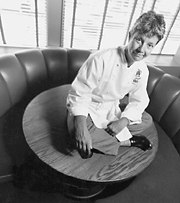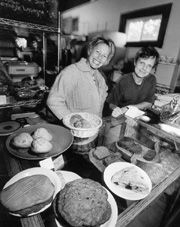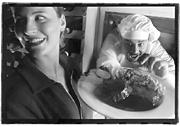Shopping in Pacific Place is a little like catalog shopping without the catalog: There’s J. Peterman, there’s J. Crew. Indeed, all the gleam and gloss inside this shopping empire is liable to induce a kind of fugue state where you begin to fantasize that you’re inside the pages of a catalog, in a world of lavish adjectives where everything looks like Pottery Barn. Even the restaurants are chains. Is there any place in this virtual world for a weary soul to refresh herself with a dose of real?
Il Fornaio
Pacific Place, Sixth and Olive, 264-0994ristorante: lunch and dinner daily, full bar risotteria: lunch and dinner daily, full bar caff躠9am-10pm daily, wine and beer panetteria: 6:30am-7pm Mon-Fri, 9am-7pm Sat-Sun major credit cards
Il Fornaio would seem the least likely candidate. We used to go to the Palo Alto branch just to laugh atthe waiters’ phony Italian accents. Nobly conceived outside of Milan in the early ’70s as a school to teach Italians the disappearing art of baking, Il Fornaio was exported to California a decade later in the form of a restaurant/bakery. Before long 13 branches had opened up and down the state, known variously for their excellent baked goods and pretentious ‘tudes; branches in Vegas, Denver, and Portland were not far behind. The Seattle outpost—a many-headed hydra consisting of an upscale restaurant, a casual storefront risotteria, a quickie atrium caff輯I>, and a panetteria, or bakery—opened along with Pacific Place at the end of October. Il Fornaio—Italian for “the baker”—is a chain restaurant’s chain restaurant.
Which is why, as we followed the host through the sleek dining room for our first meal, we were not expecting much in the way of integrity. It’s a beautiful room, all dimly lit Italian marble and wood, airily open (in the tradition of all Il Fornaios) and oriented toward the windows overlooking Sixth and Olive. (To my mind there’s something center-of-the-universe-y about this particular corner of downtown, and Il Fornaio gives one the feeling of presiding over it. Even the rain sluicing down Sixth Avenue looks scenic from here.)
One is immediately greeted with a dish of freshly poured olive oil with a swirl of aged balsamic vinegar, along with slices of fresh ciabatta bread, and olive and rosemary rolls. Here will be one’s first clue about the place, for the breads are crusty and bursting with flavor; the olive oil distinctively rich.
Because of the good bread we were inspired to follow up with an order of bruschetta, ($5.95) with sprightly tomatoes and basil piled atop slices toasted and gilded with that mouth-filling oil. Our house salad ($5.95) was bright, lusciously oiled, and topped with curls of fine Parmesan. My dinner, Il Fornaio’s signature rosemary-roasted chicken, ($13.95), was fragrant and savory; expertly roasted and simply served with mashed potatoes and saut饤 vegetables. By contrast, my companion’s lasagne ferrarese ($11.25) was miles from simple: spinach noodles, porcini mushrooms, and rich b飨amel sauce blended into a complex, earthy, and tender rendition of the classic.
Classic, indeed, was the word we kept coming back to that first dinner, as our preconceptions fell in tatters around our feet. With no sign of the soullessness that ordinarily plagues chain restaurants, Il Fornaio appeared quietly confident of what it was: a simply classic Italian restaurant devoted to high-quality ingredients. The menu holds no surprises: antipasti like polenta and carpaccio; a few basic salads and a minestrone; a handful of pizzas and a calzone; eight standard pastas; veal scaloppine and a couple of steaks. Our waiter told us this opening menu will be augmented over time, but I hope they don’t loose too much damnfool creativity over the thing. Sure enough to be simple, Il Fornaio is like a Rosellini’s for the ’90s.
On our second visit we began with the spinach salad ($7.25), with applewood smoked bacon, delectable aged ricotta, mushrooms, and toasted walnuts: just grand. The fried-squid starter ($7.95) was a light version, tempura-like, and too chewy. With it came a marinara sauce for dipping, which had a sly anchovy bite. They could have given me cowhide with this sauce.
The pizza margherita ($8.75), though it came to the table tepid, featured good strong flavors and a thin, soft crust. (Il Fornaio is every inch a bakery.) My ravioli di verdura ai funghi ($12.95) was ravioli stuffed with a Swiss chard, basil, pine nut, and Parmesan mixture, and served with mushrooms in a perky marinara. This was too chardy, no doubt about it—all other flavors were walloped into thorough submission—but I liked it anyway, being a fan of the spinach-like green.
Because we had almost come to blows over one slice of sensationally creamy tiramisu ($5.95) on the last visit, we ordered two desserts this time: chocolate mousse ($5.95), which was gussied up with raspberries and orange cr譥 anglaise and triple secsoaked cake, and zabaglione ($5.75). The former was good, the latter great; all fresh berries, orange sorbet, and a swoony creamy Marsala-rich zabaglione. This is food to make you forget your manners and abandon all conversation: You don’t go making eye contact across a table when you’ve got a dessert like this.
Since these two dinners, I’ve popped into the caff蠡nd the bakery and the risotteria on various occasions; soon I began inventing excuses to do so. (Not hard to justify: it costs an astonishing $1 to park at Pacific Place evenings.) The panetteria in the front lobby of the risotteria sells Il Fornaio’s desserts, breads, and other baked goods. I’ve now had a moist and spicy pumpkin muffin ($1.65), a buttery shortbread cookie ($1.25), and a subtly flavored crispy bakerman spice cookie ($1.25) covered with slivers of almond. Some of these I’ve had more than once; by the time you read this I’ll no doubt have had more.
The caff蠡nchors the main-floor atrium of Pacific Place’s shopping court; it’s right in the middle of everything. It sells grilled sandwiches and pizza slices and salads and even a few breakfast items (with the exception, annoyingly, of drip coffee. You have to go Italian and get an Americano). Being there for lunch we ordered sandwiches: an Italian sub on Il Fornaio’s crusty ciabatta bread ($5.50), and a grilled ham and cheese on a croissant ($3.95; in Italian, a cornetto). These were great deals: fresh, interesting sandwiches featuring good-quality meats and nice buttery breads.
Finally, there’s the risotteria, which you enter off Sixth Avenue at the corner of Olive. Even in its second week of business this casual branch of Il Fornaio had a nice streety energy, buzzing with all the activity of Seattle’s revivified downtown. It’s another classic menu—lots of antipasti and pasta and gnocchi and a nice long list of risottos (but too few salads)—with nothing more than $10. They don’t take reservations. You drop in here after catching a movie upstairs, or when the kids are feeling peckish, or when it’s the end of the month and you just need a plate of something hot. Chef Enrico Ambrosetti steps out of his open kitchen, kisses the babies, and fixes you a plate of whatever he’d serve for his family back home.
We’ve been well fed here: a simple, delicious plate of gnocchi with meat sauce ($6.50); a dish of penne pasta with pancetta in a Parmesan-rich tomato sauce ($6.50); a bewitching bittersweet eggplant salad ($3.75); an extraordinary starter of raw beef, presented in a beautiful plaid pattern on the plate with Parmesan and arugula ($4.50).
Come for the risotto, though. Casereccio ($8.50) is deeply redolent of chicken and mushrooms. Nero ($9.95), a plate of risotto black as night, features the al dente rice with shrimp and scallops in a deeply briny squid ink cream.
As we tossed our arrivadercis into the kitchen, it occurred to me that all of our Il Fornaio experiences felt oddly personal—as though we had been dining in an Italian storefront, not a glitzy shopping mall. It most likely wasn’t the service, which—though friendly and full of genuine welcome—still features young poseurs of the fake Italian accent school. (In the risotteria, especially, service needs a little help; when asked to describe the fruit tart, one tadpole earnestly explained that it was a tart with fruit.)
No, I concluded, Il Fornaio feels like the real article because it knows exactly what it is—an Italian bakery—and it’s an Italian bakery down to its bones. If it falls short of perfection it nevertheless manages character: a triumphant counterpoint, irony of ironies, to the commercialized spirit of Pacific Place.







